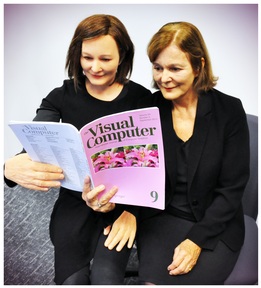People with dementia could be supported by robots in the future
The humanoid robot was created by Nanyang Technological University (NTU) In Singapore. Named after her creator, Professor Nadia Magnenat-Thalmann, director of the Institute for Media Innovation at the university, Nadine is the NTU-built EDGAR telepresence robot that could help keep care home residents and people living with dementia company in the future.

Nadine can remember names, faces and conversations. She has soft skin and brown hair, she can smile, change her expressions to show emotions and greet you with a handshake while looking you in the eye when talking.
Nadine’s physical appearance is modelled on her creator, virtual human expert Professor Thalmann who has spent three decades developing software suitable for virtual humans. She explained: “Robotics technologies have advanced significantly over the past few decades and are already being used in manufacturing and logistics. As countries worldwide face challenges of an ageing population, social robots can be one solution to address the shrinking workforce, become personal companions for children and the elderly at home, and even serve as a platform for healthcare service in future.
“Over the past four years, our team at NTU have been fostering cross-disciplinary research in social robotics technologies – involving engineering, computer science, linguistics, psychology and other fields to transform a virtual human, from within a computer, into a physical being that is able to observe and interact with other humans.
“This is somewhat like a real companion that is always with you and conscious of what is happening. So in future, these socially intelligent robots could be like C-3PO, the iconic golden droid from Star Wars, with knowledge of language and etiquette.”

Similar to the Synth’s featured in Channel 4’s ‘Humans’, Nadine is powered by technology similar to Apple’s Siri and Microsoft’s Cortana, she can act as a personal assistant in offices and homes of the future and be used as a companion to people young and old.
Unlike other robots, Nadine has her own emotions, mood and personality. She can be happy or sad depending on what the conversation is about. She also has a good memory and can recognise people she has met in the past and remember what happened her last conversations with them.
Similarly, EDGAR is a telepresence robot designed by NTU which allows it’s users to stand in front of a webcam and control EDGAR remotely from anywhere in the world. The user’s face and expressions are displayed on the robot’s face in real time, while the robot mimics upper body movements.
EDGAR also has the ability to deliver speeches from a script and has an integrated webcam allowing him to track the people he meets to engage them in conversation, responding with informative and witty replies. Robots like EDGAR and Nadine are ideally suited for use in public venues, such as shopping centres and tourist attractions as they can offer useful information to visitors.
Professor Gerald Seet works at the School of Mechanical & Aerospace Engineering and the BeingThere Centre at NTU. He commented: "EDGAR is a real demonstration of how telepresence and social robots could be used for business and education, telepresence provides an additional dimension to mobility. The user may project his or her physical presence at one or more locations simultaneously, meaning that geography is no longer an obstacle.
“In future, a renowned educator giving lectures or classes to large groups of people in different locations at the same time could be commonplace. Or you could attend classes or business meetings all over the world using robot proxies, saving time and travel costs.”
NTU is now focusing on how robots like EDGAR and Nadine can be become readily available to businesses and the public.
Latest News
 29-Jul-24
Dementia Bus gives carehome.co.uk staff insight into life with dementia
29-Jul-24
Dementia Bus gives carehome.co.uk staff insight into life with dementia
 01-Mar-24
Find out the top care homes in 2024
01-Mar-24
Find out the top care homes in 2024
 21-Mar-23
UK's top care homes in 2023 revealed
21-Mar-23
UK's top care homes in 2023 revealed
 03-Jan-23
carehome.co.uk launches free care helpline
03-Jan-23
carehome.co.uk launches free care helpline
 13-Dec-22
5 mins with Emily Whitehurst, chief operating officer for Constantia Healthcare
13-Dec-22
5 mins with Emily Whitehurst, chief operating officer for Constantia Healthcare